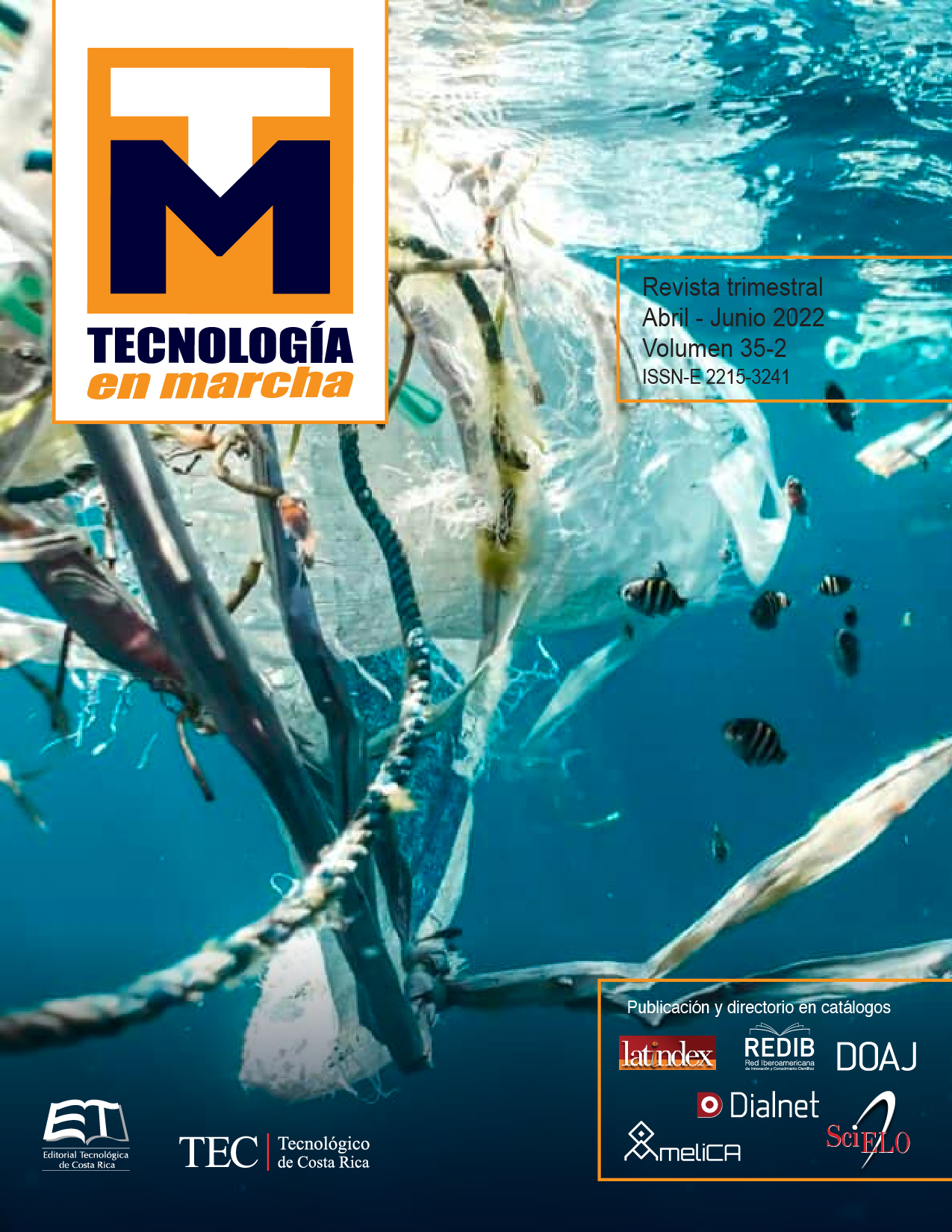Application of an inherent safety index to define the level of chemical risk: Case study in a research laboratory of a university center
Main Article Content
Abstract
The inherent safety methodology (IS) makes an analysis to try to avoid or eliminate hazards both in industries and in experimental laboratories by the evaluation of chemical risk. This methodology contemplates the adequate operation either in optimal or extreme working conditions, including physicochemical and toxicological parameters to ensure the reliability of the chemical process and to obtain an inherent safety index as a result. In this investigation, a total of 22 laboratory practices were evaluated with 76 chemical reagents with the aim of defining the level of chemical risk of a research laboratory manual of a university center, by applying an inherent safety risk index for the prevention of risks to human health and the environment. The result was an inherent safety index for the experimental chemical of 19 for the practice “Determination of oxygen, nitrogen, carbon monoxide, carbon dioxide and methane by gas chromatography”, this being the maximum core of chemical risk in the laboratory. The value obtained is very close to the theoretical inherent safety value (24), thus it is considered a risky practice.
Article Details

This work is licensed under a Creative Commons Attribution-NonCommercial-NoDerivatives 4.0 International License.
Los autores conservan los derechos de autor y ceden a la revista el derecho de la primera publicación y pueda editarlo, reproducirlo, distribuirlo, exhibirlo y comunicarlo en el país y en el extranjero mediante medios impresos y electrónicos. Asimismo, asumen el compromiso sobre cualquier litigio o reclamación relacionada con derechos de propiedad intelectual, exonerando de responsabilidad a la Editorial Tecnológica de Costa Rica. Además, se establece que los autores pueden realizar otros acuerdos contractuales independientes y adicionales para la distribución no exclusiva de la versión del artículo publicado en esta revista (p. ej., incluirlo en un repositorio institucional o publicarlo en un libro) siempre que indiquen claramente que el trabajo se publicó por primera vez en esta revista.
References
S. Hidalgo y P. Rivera, “Programa de comunicación del riesgo químico y sus alternativas de solución”, tesis MSc, Instituto Tecnológico de Costa Rica, pp. 10, 2010.
Dirección de gestión de calidad ambiental, Política Nacional de Seguridad Química. [Online]. Disponible en: http://www.digeca.go.cr/areas/politica-nacional-de-seguridad-quimica
Consejo de Salud Ocupacional, (2020, 07 de octubre), Acerca del Consejo de Salud Ocupacional, [Online]. Disponible en: https://www.cso.go.cr/quienes_somos/index.aspx#HERMES_TABS_1_1
Comisión Nacional de Emergencias, “Informe nacional de monitoreo 2019”, San José, Costa Rica, 2019.
M. Tamés, “Guía técnica para la evaluación y prevención de los riesgos relacionados con los agentes químicos presentes en los lugares de trabajo”. Editorial Instituto Nacional de Seguridad e Higiene en el Trabajo (INSHT): Madrid, pp. 12-34, 2013.
E. Medina, “Programa de gestión de los elementos de protección personal para el laboratorio químico: Reactivos SAS,” Ph.D.dissertation. Especialización en riesgos laborales, salud y seguridad en el trabajo, Corporación universitaria minuto de Dios, Bogotá, pp. no indica, 2018.
Y. Lu, “Integrating chemical Hazard assessment into the design of inherently safer processes,” Ph.D, Texas A&M University, Department of Chemical Engineering, USA, 2011.
J. Aguilar, et al. “Riesgo Químico: sistemática para la evaluación higiénica”. Editorial Instituto Nacional de Seguridad e Higiene en el Trabajo (INSHT): Madrid, pp. 11-50, 2010.
R. Jiménez, et al. “Herramientas para la gestión del riesgo químico. Métodos de evaluación cualitativa y modelos de estimación de la exposición”. Editorial Instituto Nacional de Seguridad e Higiene en el Trabajo (INSHT): Madrid, pp. 40-53, 2017.
A. Heikkilä, “Inherent safety in process plant design, Technical research center of Finland”, pp. 1–132, 1999.
J. Seral y E. Gadea, “Seguridad inherente: rutas de síntesis y diseño de procesos,” Instituto Nacional de Seguridad e Higiene en el trabajo, pp. 1-6, 2016.
S. Park, S. Xu, W. Rogers, H. Pasman y M. El-Halwagi, “Incorporating inherent safety during the conceptual process design stage: A literature review,” Journal of Loss Prevention in the Process Industries, vol. 63, nº 104040, pp. 2-28, 2019.
D. Mansfield, L. Pouler y T. Kletz, “Improving Inherent Safety,” Offshore Tecnhology Report, vol. 96, nº 521, pp. 1-61, 1996.
X. Gao, A. A. Abdul Raman, H. F. Hizaddin, and M. M. Bello, “Systematic review on the implementation methodologies of inherent safety in chemical process,” J. Loss Prev. Process Ind., vol. 65, no. March, p. 104092, 2020, doi: 10.1016/j.jlp.2020.104092.
E. Rodriguez, M. Campinas, J. L. Acero, and M. J. Rosa, “Investigating PPCP Removal from Wastewater by Powdered Activated Carbon/Ultrafiltration,” Water. Air. Soil Pollut., vol. 227, no. 6, 2016, doi: 10.1007/s11270-016-2870-7.
M. Hassim and M. Hurme, “Inherent occupational health assessment during process research and development stage”. Journal of Loss Prevention in the Process Industries, vol. 23, pp. 127-138, Jun. 2009.
P. Narváez, “Selección de la ruta química”, en Diseño conceptual de procesos químicos Metodología con aplicaciones en esterificación. Editorial Universidad Nacional de Colombia: Bogotá, pp. No indica, 2014.
Manual de laboratorio de análisis LAQAT, 2016. Universidad Nacional de Costa Rica.
Carl Roth - International, 2020. [Online]. Disponible en: https://www.carlroth.com/com/en/. [Accesado: Octubre, 6, 2020].
Fisher Scientific, 2020. [Online]. Disponible en: https://www.fishersci.com/us/en/catalog/search/sdshome.html. [Accesado: Octubre, 6,2020]
Merck, 2020. [Online]. Disponible en: https://www.merckmillipore.com/GT/es?ReferrerURL=https%3A%2F%2Fwww.google.com%2. [Accesado: octubre 6, 2020]
NIST, 2020. [Online]. Disponible en: https://www.nist.gov [Accesado: octubre 16, 2020]
Instituto Meteorológico Nacional de Costa Rica, 2020. [Online]. Disponible en: https://www.imn.ac.cr/reporte-pronostico-regional [Accesado: octubre 20, 2020]
Centro de Investigaciones Geofísicas de la Universidad de Costa Rica, 2020. [Online]. Disponible en: http://meteoro.ucr.ac.cr/estaciones/ingenieria/hist_patmos.html [Accesado: octubre 20, 2020]

